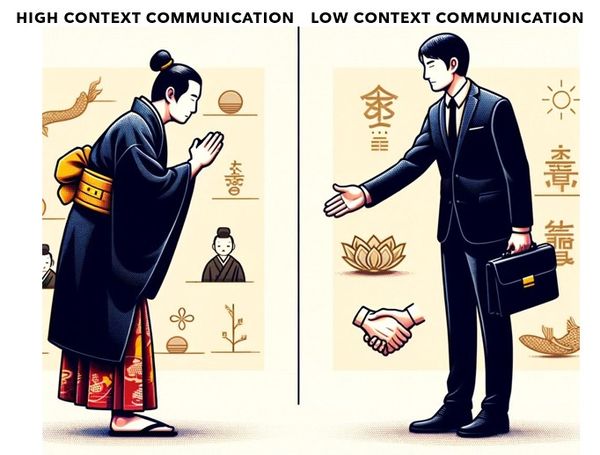0

High-Context vs. Low-Context Communication
منذ عام واحدHigh-Context vs. Low-Context Communication
Imagine communication styles as a fun, colorful art piece! On the left, we have the world of high-context communication, like a secret language of winks, nods, and shared secrets. It's like having an inside joke with your best friend. On the right, low-context communication styles are characterized by directness and explicit verbal expression. It often flourishes in societies with high immigration inflows. Not everyone shares the same unspoken rules or understands subtle cues. Direct communication helps bridge these differences, ensuring that messages are clear and understood by all.

High-Context: The Secret Code
- Greeting Colleagues: A simple smile or a knowing nod is the secret handshake here.
- Asking for Help: It's like a riddle, "Hmm, this code is quite challenging, isn’t it?"
- Feedback Time: It's all about reading between the lines. "Your report is interesting," (but maybe it needs more work).
Low-Context: Say It Like It Is!
- Greeting Colleagues in the U.S.: "Good morning, Sam! Ready for another awesome day?"
- Need Help?: Just ask! "Hey, can you show me how this gadget works?"
- Feedback, Straight Up: "Your design is great, but let's tweak the colors a bit."
The Fun Part: Adapting to Each Other
- Meetings: High-context folks might be the quiet thinkers, while low-context speakers are the chatty explainers.
- Emails: High-context might be poetic. Low-context? Straight to the point, like a list!
In the end, it's like learning a new dance. Whether you're a high-context waltzer or a low-context breakdancer, it's all about finding the rhythm and having fun with it! This approach should make the article more accessible and enjoyable, using vivid imagery and relatable examples to illustrate the differences in communication styles.
How is High Context vs Low Context Seen Across Industries!
1. In the World of Finance:
- High-Context: A banker might hint, “This investment is... quite unique,” meaning, “This might be risky.”
- Low-Context: A U.S. investor would say, “Tell me straight: what are the risks and returns?”
2. Healthcare Heroes:
- High-Context: A nurse might gently suggest, “Maybe you should rest more,” which really means, “You need to stay in bed!”
- Low-Context: A U.S. doctor says, “You must stay in bed for three days. No exceptions!”
3. The Creative Advertising Agency:
- High-Context: An ad designer might muse, “This draft is... interesting,” hinting it needs more work.
- Low-Context: The U.S. marketing manager says, “This needs more pop! Let’s make it bolder and brighter.”
4. The Buzzing World of Tech Startups:
- High-Context: A coder might imply, “This could be more efficient,” meaning, “This code needs a major revamp.”
- Low-Context: The U.S. project lead says, “This code isn’t working. Let’s refactor it for better performance.”
5. Hospitality and Tourism:
- High-Context: A hotel concierge might say, “That restaurant is quite popular,” implying, “It’s always crowded. You might not like it.”
- Low-Context: A U.S. tour guide says, “That restaurant is always packed. You might prefer somewhere quieter.”
6. Education and Academia:
- High-Context: A professor might remark, “Your essay has an interesting perspective,” hinting at a need for more evidence.
- Low-Context: A U.S. lecturer says, “Your essay needs more supporting facts and references.”
7. The Fast-Paced Retail World:
- High-Context: A salesperson might subtly suggest, “This color is very unique,” meaning, “It might not be to everyone’s taste.”
- Low-Context: In a U.S. store, the salesperson says, “This color is bold and might not suit everyone. Let’s find something more classic.”
8. The Legal Eagles:
- High-Context: A lawyer might say, “This clause could be interpreted in several ways,” hinting at potential legal risks.
- Low-Context: A U.S. attorney says, “This clause is ambiguous and could lead to legal disputes. We need to rewrite it for clarity.”
9. The Artistic World of Film and Theatre:
- High-Context: A director might suggest, “That scene has a certain... quality,” implying it doesn’t quite capture the emotion.
- Low-Context: A U.S. producer says, “The emotion in this scene isn’t hitting the mark. Let’s reshoot it with more intensity.”
10. Engineering Marvels:
- High-Context: An engineer might observe, “This design is quite traditional,” hinting at a need for more innovation.
- Low-Context: A U.S. engineering manager says, “This design is outdated. We need something more cutting-edge and efficient.”
11. The Fast-Paced World of Journalism:
- High-Context: A journalist might say, “This article is... interesting,” implying it needs more facts or excitement.
- Low-Context: A U.S. editor says, “This article lacks depth and engaging content. Add more research and lively quotes.”
12. The Dynamic Field of Event Planning:
- High-Context: An event planner might hint, “This venue has a certain charm,” meaning it might not be modern enough.
- Low-Context: A U.S. event coordinator says, “This venue is outdated for our theme. We need something more modern.”
In real-life scenarios, high-context communication can be far more intricate, relying on a rich tapestry of cultural background, shared history, and unspoken understandings that are difficult to capture in brief examples.
